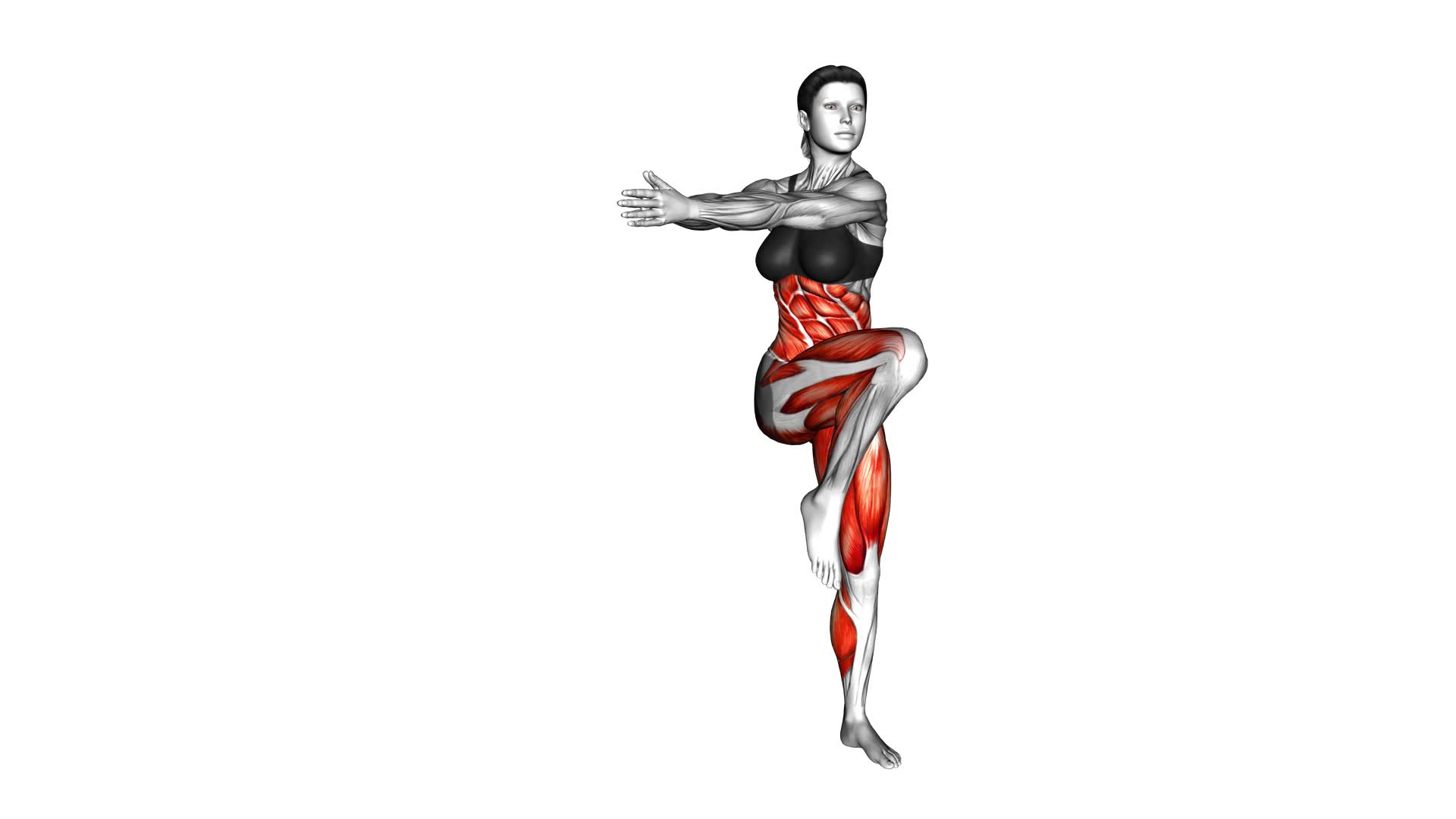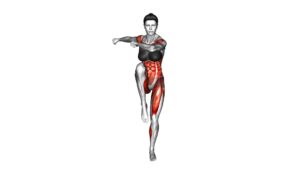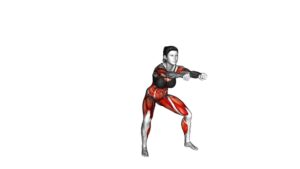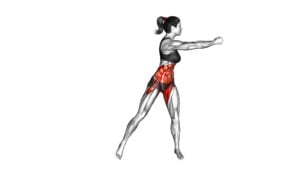Lateral Swing and Knee Raise (female) – Video Exercise Guide & Tips

Are you looking to strengthen your core and target your lower body? Then the Lateral Swing and Knee Raise exercise is perfect for you!
Watch This Exercise Video
In this video exercise guide, we'll show you the proper form and technique to get the most out of this exercise. Whether you're a beginner or an advanced fitness enthusiast, we've got modifications and advanced variations to challenge yourself.
Avoid common mistakes and maximize your workout results with our helpful tips.
Let's get started!
Key Takeaways
- Lateral Swing and Knee Raise exercises improve core strength and flexibility.
- Proper form and technique are crucial to prevent injuries and maximize benefits.
- Beginners can modify the exercises by starting with smaller movements and using support.
- Advanced variations include increasing range of motion, adding weights, and performing single-leg variations.
Benefits of Lateral Swing and Knee Raise
To maximize your workout, incorporating lateral swing and knee raise exercises into your routine can provide numerous benefits. These exercises are effective in improving core strength and increasing flexibility.
Lateral swing exercises involve moving your leg sideways in a controlled motion. This movement engages your core muscles, including your obliques and hip abductors. By consistently practicing lateral swings, you can strengthen these muscles, leading to improved stability and balance. Additionally, lateral swings target the inner and outer thigh muscles, helping to tone and sculpt your legs.
Knee raise exercises involve lifting your knee towards your chest while standing or lying down. This movement activates your core muscles, particularly your lower abs and hip flexors. By regularly performing knee raises, you can strengthen these muscles, leading to a stronger and more stable core. Strong core muscles not only enhance your athletic performance but also support proper posture and reduce the risk of back pain.
Incorporating lateral swing and knee raise exercises into your workout routine not only improves core strength but also increases flexibility. These exercises require a wide range of motion in your hips and lower body, which helps to improve flexibility and mobility. By regularly practicing these exercises, you can enhance your overall physical performance and prevent injuries during other activities or sports.
Proper Form and Technique
To ensure proper form and technique during the lateral swing and knee raise exercise, there are a few common mistakes to avoid. These include:
- Swinging your leg too forcefully
- Using momentum instead of controlled movements
- Not engaging your core muscles
To prevent injuries, it's important to warm up before starting the exercise and to listen to your body's limits.
Finally, to get the most out of this exercise, experts recommend:
- Maintaining a steady pace
- Keeping your movements smooth and controlled
- Focusing on engaging the targeted muscles.
Common Mistakes to Avoid
Avoid these common mistakes when performing the lateral swing and knee raise exercise to ensure proper form and technique.
- One common mistake isn't engaging your core muscles throughout the entire movement. Remember to keep your abdominal muscles tight and your back straight to maintain stability and prevent injury.
- Another mistake to avoid is swinging your legs too forcefully, which can strain your hip flexors and lower back. Instead, focus on controlled movements that target the intended muscles.
- Additionally, be mindful of your posture during the exercise. Avoid rounding your shoulders or hunching forward, as this can lead to poor form and decreased effectiveness.
Injury Prevention Tips
Injury prevention techniques are crucial to avoid any potential harm during this exercise. Before starting, it's important to warm up your body with dynamic stretches and mobility exercises. This helps to increase blood flow, loosen up the muscles, and prepare your body for the workout.
When performing the lateral swing and knee raise, focus on maintaining a neutral spine and engaging your core muscles. Avoid swinging your leg too forcefully, as this can put excessive strain on your hip joints. Instead, aim for controlled and smooth movements.
Additionally, be mindful of your knee alignment and avoid any inward or outward collapsing. By following these injury prevention tips and maintaining proper form and technique, you can minimize the risk of injuries during this exercise.
Expert Form Recommendations
Maintain a neutral spine and engage your core muscles to ensure proper form and technique during the lateral swing and knee raise exercise, reducing the risk of injuries. Here are some expert form recommendations to help you perform this exercise correctly:
- Keep your chest lifted and shoulders relaxed to avoid straining your neck and upper back.
- Focus on using your hip muscles to initiate the lateral swing, rather than relying on momentum.
- Control the movement and avoid swinging your legs too forcefully to prevent strain on your hip joints.
- Keep your knees slightly bent and avoid locking them during the knee raise to protect your knee joints.
Modifications for Beginners
If you're new to the lateral swing and knee raise exercise, there are simplified beginner modifications that you can try. These modifications make the exercise easier and more accessible for beginners.
Additionally, there are easy progressions that you can gradually work towards as you become more comfortable and confident with the exercise.
Simplified Beginner Modifications
Start with modified variations of the lateral swing and knee raise exercises to cater to beginners. These beginner modifications will help you ease into the exercises while maintaining proper technique. Here are some simplified variations to get you started:
- Start with smaller swings: Begin by swinging your leg laterally at a lower height to build strength and stability before gradually increasing the range of motion.
- Use a support: If you're struggling with balance, hold onto a sturdy object like a chair or wall for stability while performing the knee raises.
- Reduce intensity: Slow down the tempo of the movements to focus on control and stability, especially if you're finding the exercises too challenging at first.
- Modify range of motion: Limit the range of motion of the knee raises by bringing your knee up to a comfortable height, gradually increasing it as you become more comfortable.
Easy Progressions for Beginners
To progress as a beginner, you can make modifications to the lateral swing and knee raise exercises by incorporating simple variations.
These modifications are important for injury prevention and to gradually build strength and flexibility. One modification you can try is reducing the range of motion. Instead of swinging your leg all the way out to the side, start with a smaller swing and gradually increase it as you get more comfortable.
Another modification is to use a resistance band or ankle weights to add some resistance to the exercise. This will help to further challenge your muscles and improve your overall strength.
Remember to listen to your body and only do what feels comfortable for you. These modifications will help you progress at your own pace and prevent any potential injuries.
Gentle Variations for Beginners
To modify the lateral swing and knee raise exercises for beginners, incorporate gentle variations that gradually increase range of motion and add resistance using ankle weights or a resistance band. Here are four beginner modifications and injury prevention techniques to help you get started:
- Start with smaller movements: Begin with smaller swings and knee raises, focusing on proper form and control. This allows your muscles to adapt and reduces the risk of injury.
- Use a chair for support: If balance is a concern, use a chair for support while performing the exercises. This helps you maintain stability and prevents falls.
- Reduce the range of motion: Limit the range of motion in the swings and knee raises to a comfortable level. As you gain strength and flexibility, gradually increase the range of motion.
- Avoid adding resistance initially: Instead of using ankle weights or resistance bands from the start, focus on mastering the exercises without added resistance. This helps build a strong foundation before progressing to more challenging variations.
Advanced Variations to Challenge Yourself
Challenge yourself with advanced variations of the Lateral Swing and Knee Raise exercise to enhance your strength and coordination. These advanced modifications will take your workout to the next level and push your limits.
Here are some tips for increasing the difficulty of this exercise.
- Increased range of motion: Start by extending your legs fully during the swing and knee raise. This will require more control and core strength to maintain balance.
- Add weights: Hold a dumbbell or kettlebell in your hands while performing the exercise. The added resistance will challenge your muscles even more and help you build strength.
- Single-leg variation: Instead of using both legs, try performing the exercise with one leg at a time. This will require extra stability and engage your core and hip muscles more intensely.
- Speed it up: Increase the tempo of your movements to make the exercise more challenging. This will also help improve your coordination and agility.
Remember to always maintain proper form and technique while performing these advanced variations. Start with lighter weights and gradually increase the difficulty as you get stronger. Challenge yourself, but listen to your body and don't overexert yourself.
With consistent practice, you'll see improvements in your strength, coordination, and overall fitness level.
Common Mistakes to Avoid
Avoiding common mistakes is crucial for maximizing the effectiveness of the Lateral Swing and Knee Raise exercise and preventing injury. To ensure you get the most out of this exercise and stay safe, here are some technique tips to keep in mind:
- Don't rush: One common mistake is performing the exercise too quickly. Slow and controlled movements are key for targeting the right muscles and maintaining proper form.
- Avoid swinging the legs: Swinging your legs instead of using your core muscles can take away the benefits of this exercise. Focus on engaging your abs and using them to lift your legs sideways.
- Keep your upper body stable: It's important to maintain a stable upper body throughout the exercise. Avoid leaning forward or backward, as this can put strain on your lower back.
- Don't neglect the knee raise: Remember to bring your knees up towards your chest as you swing your legs sideways. Neglecting the knee raise can reduce the effectiveness of the exercise.
By avoiding these common mistakes, you can ensure that you're performing the Lateral Swing and Knee Raise exercise correctly and maximize its benefits.
Now, let's move on to the next section to discover some tips to further enhance your workout results.
Tips to Maximize Your Workout Results
To further enhance your workout results, it's essential to incorporate these tips into your routine. By maximizing calorie burn and implementing effective workout strategies, you can make the most out of your exercise sessions.
Firstly, consider incorporating high-intensity interval training (HIIT) into your routine. This involves alternating between short bursts of intense exercise and periods of rest. HIIT has been shown to increase calorie burn and improve overall fitness levels.
Another tip is to vary your workouts. Your body adapts to repetitive movements, so it's important to switch things up. Try different exercises, use different equipment, and challenge yourself with new routines. This not only keeps your workouts interesting but also prevents plateaus and helps you continue making progress.
In addition, don't forget about the importance of proper nutrition. Fueling your body with the right foods can optimize your workout results. Focus on consuming a balanced diet that includes lean proteins, whole grains, fruits, and vegetables. Stay hydrated and consider consulting with a registered dietitian for personalized advice.
Lastly, listen to your body and give yourself adequate rest days. Pushing too hard without proper recovery can lead to burnout or injury. Resting allows your muscles to repair and grow stronger, ensuring better long-term results.
Frequently Asked Questions
Is the Lateral Swing and Knee Raise Exercise Suitable for Pregnant Women?
Yes, the lateral swing and knee raise exercise can be suitable for pregnant women. However, it's important to modify the exercise to ensure the safety and comfort of the mother and baby.
Pregnancy modifications may include reducing the range of motion, using lighter weights or resistance bands, and avoiding any movements that cause discomfort or strain.
The benefits of this exercise for pregnant women include strengthening the core and hip muscles, improving balance, and promoting overall fitness during pregnancy.
How Many Calories Can Be Burned by Performing the Lateral Swing and Knee Raise Exercise?
To burn calories with the lateral swing and knee raise exercise, focus on performing the movements with intensity. This exercise engages multiple muscle groups, leading to an effective calorie burn.
However, it's important to take safety precautions and listen to your body. Start with a warm-up, maintain proper form throughout, and gradually increase the intensity as your fitness level improves.
Remember to consult with a healthcare professional before starting any new exercise program, especially if you have any underlying health conditions.
Can the Lateral Swing and Knee Raise Exercise Help in Reducing Belly Fat?
The lateral swing and knee raise exercise is a great addition to your weight loss routine. It targets your abs and can help reduce belly fat.
By incorporating this exercise into your workouts, you can increase the effectiveness of toning your abs. Not only does it work your core muscles, but it also burns calories and strengthens your legs.
What Are Some Alternative Exercises That Target the Same Muscle Groups as the Lateral Swing and Knee Raise?
If you're looking for alternative exercises that target the same muscle groups as the lateral swing and knee raise, there are a few options you can try.
Side plank with leg lift, standing side leg lifts, and standing knee-to-elbow crunches are all great alternatives. These exercises engage your core and work your obliques, just like the lateral swing and knee raise.
Remember to listen to your body and modify any exercises if you're pregnant to ensure safety and comfort.
How Long Should One Wait After a Meal Before Performing the Lateral Swing and Knee Raise Exercise?
To get the most out of your lateral swing and knee raise exercise, it's important to know how long to wait after a meal. Waiting at least 30 minutes is recommended to avoid discomfort and allow for proper digestion.
Incorporating this exercise into your regular routine has many benefits, including strengthening your core, improving balance, and toning your hips and thighs.
To ensure proper form and technique, focus on engaging your abdominal muscles, keeping your back straight, and lifting your knees as high as possible.
Conclusion
Incorporating lateral swings and knee raises into your workout routine can offer numerous benefits. These exercises improve core strength, stability, and flexibility. By maintaining proper form and technique, you can maximize the effectiveness of these exercises.
Beginners can start with modifications and gradually progress to more advanced variations. This allows them to challenge themselves and gradually build their skills and strength. Avoiding common mistakes and following these tips will help you achieve optimal results from your workouts.

Author
Years ago, the spark of my life’s passion ignited in my mind the moment I stepped into the local gym for the first time. The inaugural bead of perspiration, the initial endeavor, the very first surge of endorphins, and a sense of pride that washed over me post-workout marked the beginning of my deep-seated interest in strength sports, fitness, and sports nutrition. This very curiosity blossomed rapidly into a profound fascination, propelling me to earn a Master’s degree in Physical Education from the Academy of Physical Education in Krakow, followed by a Sports Manager diploma from the Jagiellonian University. My journey of growth led me to gain more specialized qualifications, such as being a certified personal trainer with a focus on sports dietetics, a lifeguard, and an instructor for wellness and corrective gymnastics. Theoretical knowledge paired seamlessly with practical experience, reinforcing my belief that the transformation of individuals under my guidance was also a reflection of my personal growth. This belief holds true even today. Each day, I strive to push the boundaries and explore new realms. These realms gently elevate me to greater heights. The unique combination of passion for my field and the continuous quest for growth fuels my drive to break new ground.







